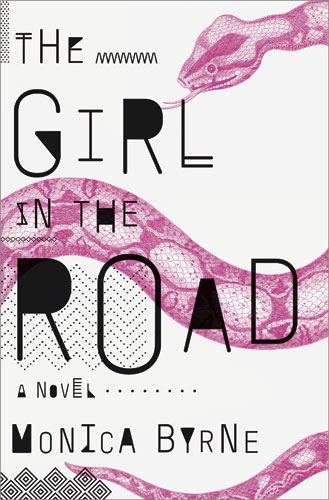The Girl in the Road, the enthralling debut novel by Monica Byrne ’03, takes place in a world where “Wave” is the next frontier of artificial energy. It is 2068, India is the dominant global power, and a long pontoon bridge stretches from Mumbai to Djibouti and makes energy with metallic hydrogen threads, solar panels, waves, and intelligent chips. (The bridge is called the Trans-Arabian Linear Generator, or the Trail.) In this society, the government can follow one’s every move with tracking devices. And heroine Meena has woken up with painful snakebites—possibly thanks to a terrorist organization. To escape danger, she decides to flee India by walking more than 3,000 kilometers on the Trail.
Besides its distance, the Trail is not an easy route out of the country. For one, it’s illegal to walk on it, though a subculture of walkers has emerged, complete with a black market for useful supplies. (Tech geeks will love the devices and tools that Byrne has invented to keep Meena fed, sheltered, entertained, and alive.) Balancing on the floating and bobbing bridge is impossibly difficult, and Meena keeps a nocturnal schedule to avoid harsh sunlight on the open water. It is exhilarating to watch her slowly make her way across the wide Arabian Sea.
Early in Meena’s journey, a lover makes a prescient comment that echoes throughout the novel: “Relationships never end. Once made, they just influence each other backwards and forwards in time, for better or worse.” Meena’s narrative alternates with that of Mariama, a young slave from Mauritania who makes an escape of her own decades before, hitching a ride in a caravan headed toward Ethiopia. Discovering how the two women connect—backward and forward in time—is one of the greatest rewards of this suspenseful tale.
Longtime readers of Wellesley magazine will remember Byrne’s name from the cover story she wrote in the fall of 2009; in “Writer Without Borders,” Byrne detailed her adventures abroad as a recipient of Wellesley’s Mary Elvira Stevens Traveling Fellowship. As a Wellesley alumna, it is satisfying to read the creative work that no doubt resulted, in part, from that gift of money and time, which the College awards to several alumnae per year. As a voracious reader and a feminist, it is even more satisfying to read a terrific female-driven adventure story in a non-American setting that’s absent from so much of contemporary popular fiction. In The Girl in the Road, set in a future that feels eerily realistic, sexuality is fluid, and women are tough and capable of risky and harrowing quests. The one true protector figure of this story is Yemaya, a goddess-like woman who changes the course of Mariama’s life.
In her first book, Byrne has built a vivid (and often terrifying) world that will appeal to a wide range of readers—most obviously speculative fiction fans, though many a book club would enjoy arguing over the symbolism and plot points of this epic. Here’s hoping for another novel from an imaginative and gifted author.
Borné is managing editor of the Oxford American magazine. She lives in Little Rock, Ark.








We ask that those who engage in Wellesley magazine's online community act with honesty, integrity, and respect. (Remember the honor code, alums?) We reserve the right to remove comments by impersonators or comments that are not civil and relevant to the subject at hand. By posting here, you are permitting Wellesley magazine to edit and republish your comment in all media. Please remember that all posts are public.